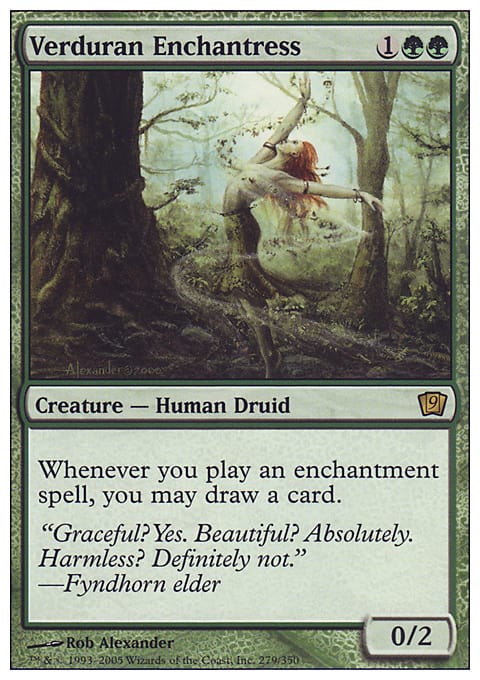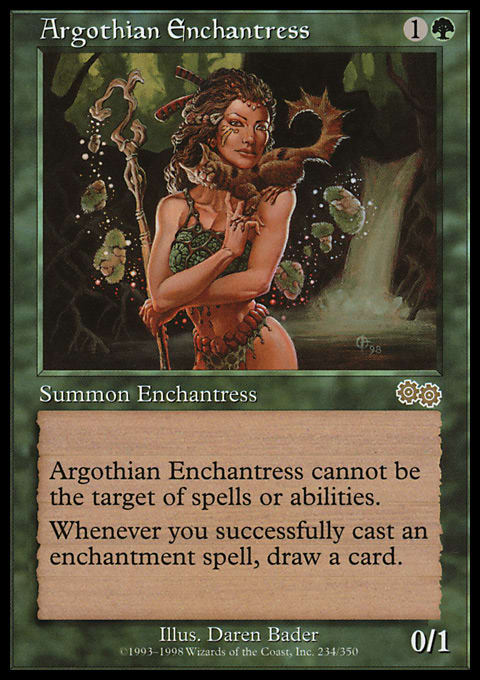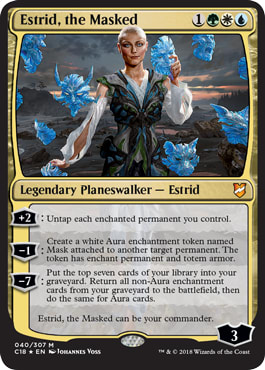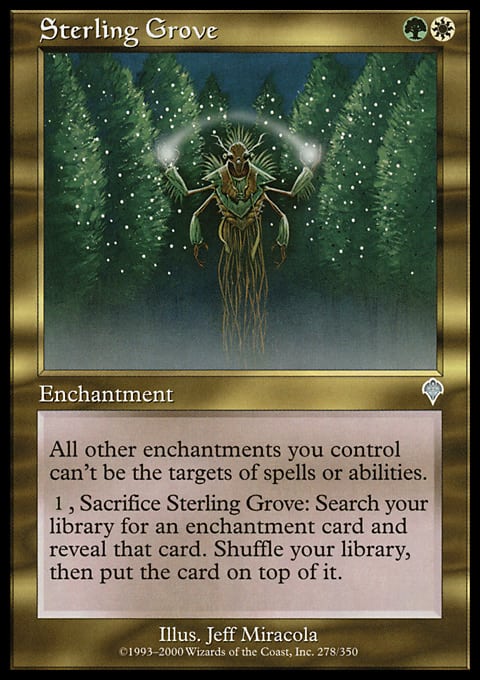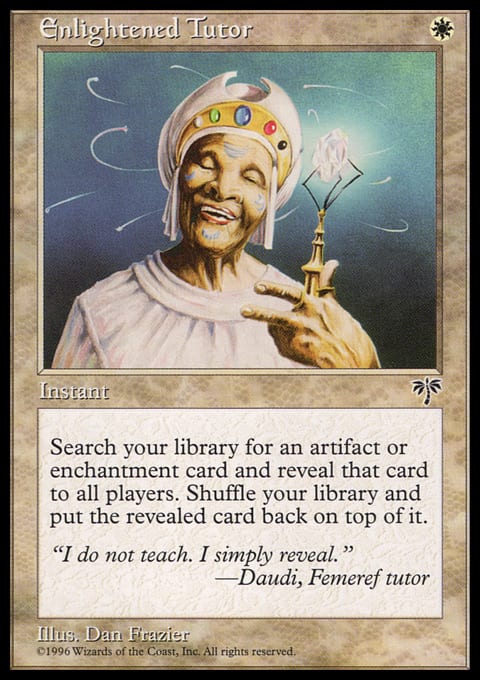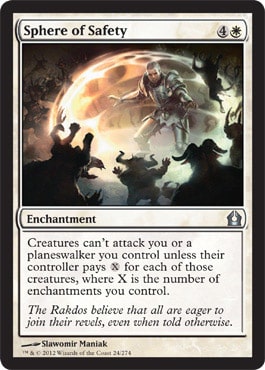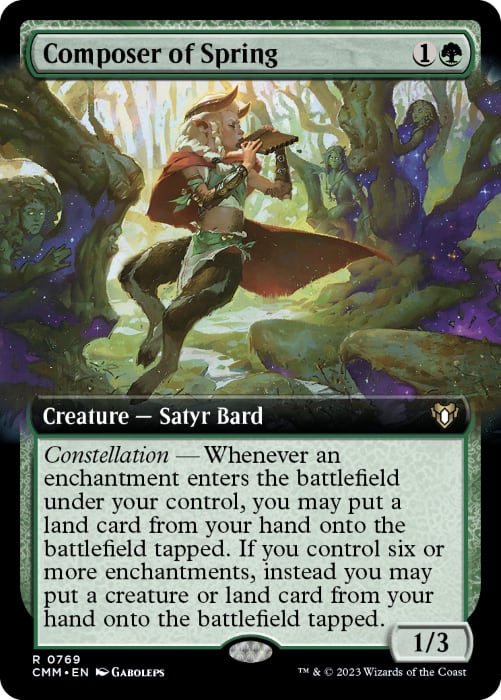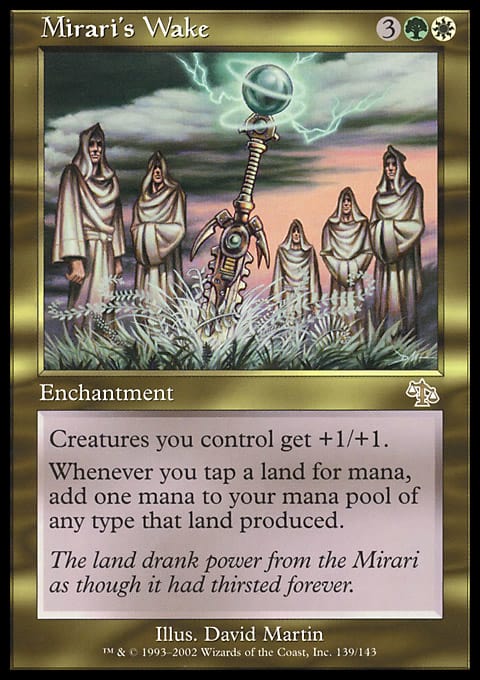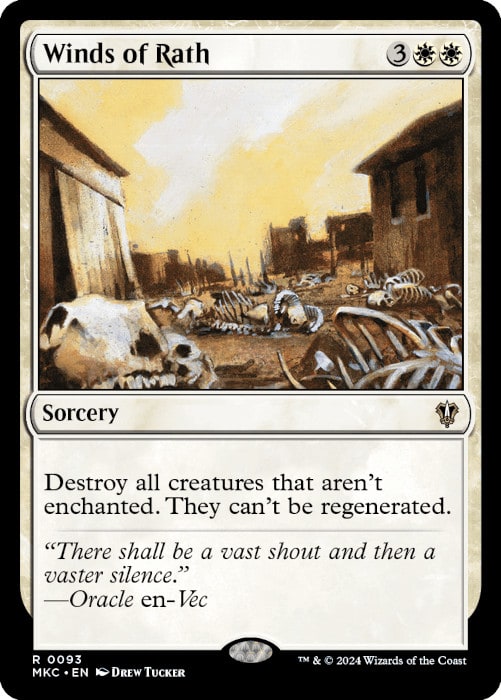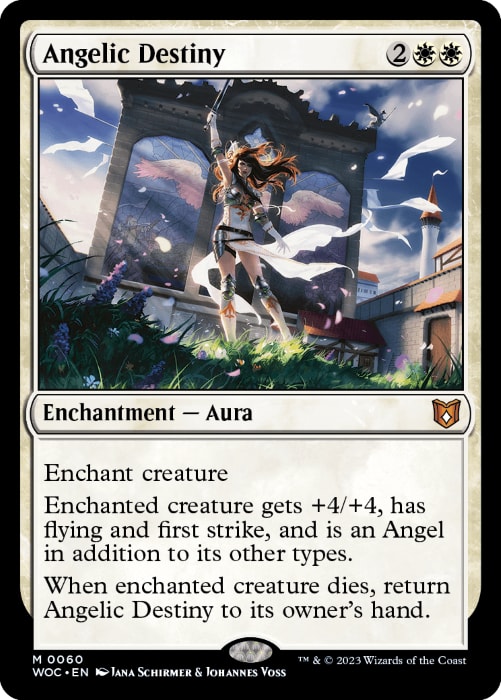Some of Magic's most powerful Commander cards - Rhystic Study, Smothering Tithe, Parallel Lives - come in the form of Enchantments. Wind the clock back to the game' earliest years, and you'll find plenty more enchanting powerhouses still played today like Necropotence, Sylvan Library, and Land Tax. However, while Commander decks often pack plenty of ways to remove Creatures and Artifacts, Enchantments are often overlooked. Or only accounted for under the umbrella of versatile removal (Farewell, Anguished Unmaking, etc.). Because of this, you end up with a large collection of powerful effects, most of which stay on the board until removed, that opponents have fewer means to deal with.
This formula makes enchantments an alluring prospect, one that few strategies make better use of than Enchantress.
Named after Alpha's Verduran Enchantress, this game plan rewards you for playing as many Enchantments as possible. The namesake enchantress cards are the foundations of the deck. They're your payoffs, rewarding you most often with card draw (Argothian Enchantress, Setessan Champion, Mesa Enchantress, Enchantress's Presence, Eidolon of Blossoms, Satyr Enchanter), but also creatures (Sigil of the Empty Throne, Archon of Sun's Grace, Ajani's Chosen) and stats-boosts (Yavimaya Enchantress, Destiny Spinner, Boon of the Spirit Realm). If we delve even deeper into the Aura subtype, a slew of additional options open up (Sram, Senior Edificer, Kor Spiritdancer, Light-Paws, Emperor's Voice).
The entire Constellation mechanic revolves around an Enchantress framework, triggering each time an enchantment enters the battlefield under your control. While this archetype is usually in the wheelhouse of White/Green, Constellation's introduction in Journey into Nyx spread the synergy across the entire color pie (Ex. Whitewater Naiads, Doomwake Giant, Forgeborn Oreads). We now see Enchantment strategies among multiple color combinations, each adding unique twists like life drain (Eriette of the Charmed Apple), evasion (Eutropia the Twice-Favored), or both (Tatsunari, Toad Rider).
Because the most frequent payoff for Enchantress triggers is card-draw, this archetype is able to make powerful plays while keeping its hand full. As you draw into more enchantress cards, resources grow at an exponential level. Even in the event of a Farewell, your hand should remain full of cards to rebuild with.
But among those cards, what are the true staples for the deck? Let's explore further:
Commanders
The vast majority of enchantress-effects lie in White/Green, so the lion's share of potential Commanders fall within this pair. Sythis, Harvest's Hand is the most straightforward, and powerful, option to lead with. She comes down early and gives your deck a constant source of card advantage in the command zone. But card advantage doesn't just come from drawing cards, as Calix, Guided by Fate and Yenna, Redtooth Regent illustrate. These generals forge copies of your enchantments, completely bypassing mana costs. If you're more in mood for Auras, Commanders like Siona, Captain of the Pyleas, Gylwain, Casting Director, and Ellivere of the Wild Court all generate the kind of value you'd expect from an enchantress-engine.
These characters only scratch the surface, so here are some other Enchantment-centric generals across the color pie:
Bant: Tuvasa the Sunlit, Kestia, the Cultivator, Estrid, the Masked, Galea, Kindler of Hope, Amareth, the Lustrous
Esper: Alela, Artful Provocateur, Zur the Enchanter, Zur, Eternal Schemer, Eriette, the Beguiler
If you'd like to learn more about Zur, Eternal Schemer, feel free to check out "Crazy-Zur's Discount Enchantment Warehouse"
Boros: Three Dog, Galaxy News DJ, Tiana, Ship's Caretaker, Cass, Hand of Vengeance, Feather, Radiant Arbiter, Wyleth, Soul of Steel, Kellan, the Fae-Blooded
Gruul: Chishiro, the Shattered Blade, Kaima, the Fractured Calm
Grixis: Lynde, Cheerful Tormentor
Naya: Mazzy, Truesword Paladin, Dogmeat, Ever Loyal, Preston Garvey, Minuteman
Abzan: Myrkul, Lord of Bones, Anikthea, Hand of Erebos, Narci, Fable Singer
Mardu: Ghen, Arcanum Weaver
5-Color: Go-Shintai of Life's Origin
If you'd like to learn more about the Honden-centric Go-Shintai of Life's Origin, feel free to check out "Go-Shintai! Go-Shintai! Go!"
That's a whole bunch of potential commanders, but the list is by no means comprehensive. Plenty of other Enchanting options are out there if the above choices don't interest you.

Enchantress's Presence by Rebecca Guay
Tutors
As powerful as enchantments can be, we need to find them first. Fortunately, a plethora of enchantment tutors, many of which are budget-friendly, have been printed over the years. Enlightened Tutor, Idyllic Tutor, Lost Auramancers, Plea for Guidance, Moon-Blessed Cleric, and even the oddball Wild Research ensure your strongest effects are just a search n' shuffle away. Academy Rector takes the power even further, especially when paired with sacrifice/recursion synergies, but her Reserved List status has elevated her price tag well past $60.00. If your Commander table is okay with gold-bordered cards, you can find the World Championship Decks 2000 version for under $20.
Another staple is Sterling Grove, which protects your other enchantments from removal until you're ready to cash it in for the tutor effect. Early resilience plus late game utility is the recipe for some of the best Magic cards, and Sterling Grove is no exception. This was one of the pricier cards from Invasion until it received a much needed reprint in Modern Horizons 2.
If you focus on Auras, even more options abound. Auratouched Mage and Boonweaver Giant are far larger than their base stats imply, fetching up haymakers like Eldrazi Conscription. Heliod's Pilgrim, Shrine Steward, and Totem-Guide Hartebeest also fetch up Auras upon ETB, making all of these creatures prime candidates for Flickerform. Sovereigns of Lost Alara goes a step further, grabbing a free Aura each time a creature attacks alone. Other Aura-centric tutors include Open the Armory, Light-Paws, Emperor's Voice, Three Dreams, Axgard Armory, Tallowisp, and the adventure-side of Kellan, the Fae-Blooded.
Heck, there's even options if you're running Curses with Lynde, Cheerful Tormentor, as both Curse of Misfortunes and Bitterheart Witch provide your hex of choice to make opponents miserable.
Scaling Effects
Enchantress decks want to play as many enchantments as possible, not just for the sake of card draw, but also the myriad of scaling effects available. For personal defense, Sphere of Safety can make attacking you not worth the mana investment, if even feasible at all. Harsh as the drawback to Solitary Confinement may appear, your sheer volume of enchantress effects can easily make the discard negligible. You could also generate an ever-growing army of blockers via Hallowed Haunting, which switches to an offensive card once your spirits grow large enough and gain evasion.
Speaking of offense, plenty of stats-boosting effects scale with enchantment count. All that Glitters was so strong it received a Pauper-ban, but it's fair game in Commander. Plenty of other weapons like Ancestral Mask, Auramancer's Guise, Michiko's Reign of Truth, Eidolon of Countless Battles, Boon of the Spirit Realm, Ethereal Armor, Helm of the Gods, and the Disturb-half of Katilda, Dawnhart Martyr // Katilda's Rising Dawn turn even the most unassuming creatures into monsters. Sage's Reverie even goes the extra mile and draws you cards. Card advantage also comes in the form of Ondu Spiritdancer, whose doubling-effect accelerates our strategy.
As you build up a hearty enchantment collection, you can bet it'll draw a sizeable crosshair. To shield all your enchantments and enchanted creatures, call upon the power of Greater Auramancy. This card was very expensive until Wilds of Eldraine: Enchanting Tales provided a much-needed reprint.
Mana production can also skyrocket with enchantment count. Sanctum Weaver's status as an enchantment creature means it already taps for a single mana of any color all on its own. Before long, it'll be generating more mana than a Gilded Lotus. Having two card types makes Sanctum Weaver especially vulnerable to removal, but that's not the case with Serra's Sanctum, another budget-breaker on the Reserved List.
While we're on the topic of ramp...
Mana Production
Green has ample means of ramp, but most involve searching for additional land. For enchantress decks, especially those led by Estrid, the Masked, consider auras like Overgrowth, Dawn's Reflection, and Weirding Wood. There is the fear of enemy Demolition Fields and whatnot, but often the rewards outweigh the risks. Not only should these be drawing you cards off your enchantress effects, but they'll continue to add to your total enchantment count.
Plenty of enchantment creatures also provide mana-support, either via Constellation (Composer of Spring, Nessian Wander), playing lands off the top of your deck (Courser of Kruphix), cost-reduction (Jukai Naturalist, Herald of the Pantheon, Transcendent Envoy), or color-fixing (Dryad of the Ilysian Grove). Starfield Mystic and Hero of Iroas help too, just note they lack their coworkers' enchantment-status.
If you really want to go big, seek out mana-doublers like Mirari's Wake, Nyxbloom Ancient, Zendikar Resurgent, Mana Reflection, and Virtue of Strength.
Removal
Aura Shards has been a Commander staple for years, taking down enemy artifacts/enchantments with each creature played. Most decks will have viable targets, often in the forms of mana rocks, though this'll certainly take care of nastier artifacts and enchantments, too. Aura Shards' mere presence on the battlefield will discourage opponents from playing scary cards until Aura Shards is removed. Though our deck is more interested in having enchantments enter the battlefield than it is creatures, plenty of our creatures also happen to be enchantments (Weaver of Harmony, Aegis of the Gods, Nyxbloom Ancient Courser of Kruphix), giving us the best of both worlds.
When it comes to creature removal, White is known for its Oblivion Ring effects, but there's a problem in Commander. Pointing a Banishing Light at an enemy commander will most often result it in going back to the Command Zone rather than stay exiled. To get around this, consider removal that'll leave generals in play, but render them less effective. Arrest-style effects like Prison Term, Planar Disruption, and Prison Sentence lock down creatures without removing them from play. The only issue is how triggered abilities won't be affected, so enemy commanders like Miirym, Sentinel Wyrm or Tymna the Weaver are still dangerous. Another option is to transform enemy generals into something else. Darksteel Mutation, Imprisoned in the Moon, and Song of the Dryads remove the original abilities card types of the creature they enchant. What's more, unlike something like Reprobation or Lignify, these spells make it more difficult to kill the enchanted creature. A Thraximundar livin' the amphibian life with Frogify can still chump block, going back to the Command Zone for a recast later. While Darksteel Mutation's gift of Indestructible makes the zombie-assassin (now a bug) harder to kill, that's actually a good thing because his tiny frame will stay in play. Imprisoned in the Moon and Song of the Dryads go even further by turning creatures into lands, vastly limiting what forms of removal can target them.
But no matter what form of the above removal you go with, they're all Auras, which'll trigger enchantresses, scale up our enchantment count, and be open for tutoring.
There are even enchantment-centric options for mass-removal. Planar Collapse comes down early and ensures the board doesn't get too swarmed. Winds of Rath ignores all your enchanted creatures as its wipes out everyone else. Sagas like The Akroan War, Battle of Frost and Fire, Phyrexian Scriptures, and Vault 75: Middle School 'wrath the board (among additional effects), then place themselves into the graveyard for use with...
Recursion
We begin this section with another Reserved-List powerhouse: Replenish. With a full graveyard, this sorcery warps the entire game in your favor. It's telling that more recent versions of this effect have balanced it out via benefitting all players (Open the Vaults, limiting what can be brought back (Retether, Mantle of the Ancients), increasing casting cost (Dance of the Manse, Brilliant Restoration, Triumphant Reckoning), adding time/effort (Resurgent Belief, Crystal Chimes), or working in installments (Starfield of Nyx).
Wizards of the Coast has also done a lot to mitigate the inherent risk of Auras via designs that recur themselves upon hitting the graveyard (Angelic Destiny, Draconic Destiny, Rancor, The Sound of Drums, Gryff's Boon). But even among aura that can't revive themselves, plenty of other incentives exists. From replacing themselves (Audacity, Sticky Fingers), drawing a card upon entering play (Unquestioned Authority, Karametra's Favor, or providing extra protection (Bear Umbra, Octopus Umbra), you've ample means to prevent enemy removal 2-for-1's.
And certainly don't forget about Hall of Heliod's Generosity in your mana base!
If you think I missed anything when it comes to Enchantress-staples, you're probably right. The library is vast. Synergistic cards have been around since Magic's beginning, and as time goes on, we'll only get more. I hope today's adventure has at least provided a solid foundation to build on. A mountain of choices can feel daunting to parse through, but provides the best opportunity for creative deck-building.
Thanks for reading, and have an enchanting day!
-Matt-
















